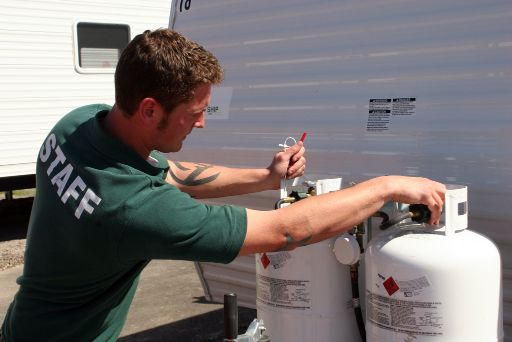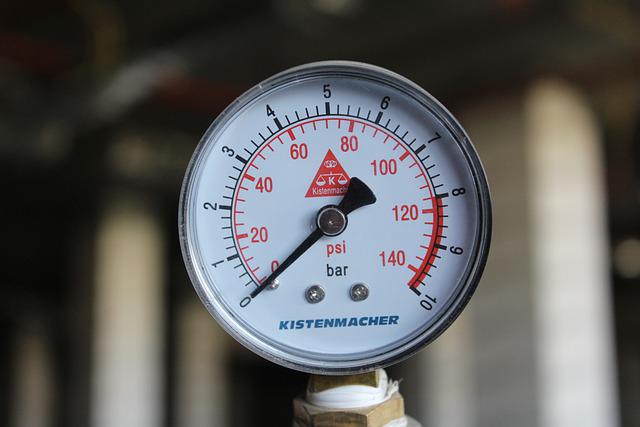
If your propane tank is positioned less than 47 meters away from your house, using a 3/4 inch outer diameter size of propane line is typically recommended by technician. This size is effective in providing an adequate supply of gas to your home’s appliances, ensuring optimal performance and safety.
The 3/4 inch propane line can accommodate various flow rates and pressure requirements, depending on the specific demands of your appliances. When choosing the right size for your propane line, it is essential to consider the total BTU (British Thermal Units) requirements of all the appliances connected to the system. The line should be able to handle the combined BTU load to guarantee a reliable and efficient operation.
In some cases, longer propane lines might be needed, especially if the distance between the tank and the house exceeds 47 meters. When dealing with longer distances, it is crucial to account for potential pressure drops and increased friction losses along the line. In these situations, a larger diameter propane line may be necessary to maintain an adequate flow of gas to the appliances.
Local building codes, regulations, and safety standards may vary, so consulting with a licensed professional is highly recommended. They can help you determine the most appropriate size and type of propane line for your specific installation, ensuring that your system is safe, efficient, and compliant with all applicable guidelines.
| Propane Line Size | Usage | Examples | Pros | Cons |
|---|---|---|---|---|
| 1/4 inch | Mainly for single appliances or limited BTU loads. | Small outdoor grills, Patio heaters, Single-room heaters | Less expensive; Easier to install in tight spaces. | Limited BTU capacity; Not suitable for multiple appliances or long runs. |
| 3/8 inch | Average residential use; Supports several appliances. | Standard home cooking ranges, Water heaters, Central heating for average homes | Good balance between size and BTU capacity; Suitable for most average-sized homes. | May not suffice for large homes or high-demand appliances. |
| 1/2 inch & Larger | Larger homes, commercial applications, long distances from tank. | Larger homes with multiple appliances, Commercial kitchens, Far from tank scenarios | High BTU load accommodation; Suitable for long distances. | More expensive; More labor-intensive installation. |
Read related article: How to Choose the Best Propane Tank for Your Needs?
Factors Determining the Proper Size of a Propane Line
Propane gas, a popular choice for heating homes and powering appliances, needs to be delivered efficiently and safely from the storage tank to the house. The right line size ensures adequate supply while reducing safety risks. Several factors influence the correct size of a propane line. Let’s delve into these determining elements.
Total BTU Load:
- Understanding BTU: BTU (British Thermal Unit) is a measure of heat energy. Every propane appliance, be it a furnace, stove, or water heater, has a BTU rating which represents the amount of propane it consumes when operating at maximum capacity.
- Aggregate Demand: To determine the appropriate line size, sum up the BTU ratings of all propane appliances in the house. This gives a total BTU load, a crucial number which indicates the maximum possible propane consumption at any given time.
- Line Size Relevance: A line that’s too small may not be able to deliver the necessary propane to meet the combined BTU demand of all appliances, leading to inefficiencies or even safety hazards.
Distance from Tank to House:
- Pressure Drop Over Distance: As propane travels through a line, there’s an inevitable drop in pressure. The longer the distance, the more significant this drop becomes.
- Diameter & Distance: A larger diameter pipe can reduce the effect of this pressure drop. For longer distances between the tank and house, a larger diameter might be necessary to ensure consistent and safe propane delivery.
Elevation Changes:
- Gravity’s Role: Propane, being heavier than air, is influenced by gravity. If there’s a significant elevation change, like when a tank is placed uphill or downhill from the house, it can impact the propane’s flow.
- Compensating for Elevation: Elevation changes may necessitate adjustments in line size. For instance, if a tank is placed uphill, gravity can assist the flow, potentially allowing for a smaller line. Conversely, if the tank is downhill, the line might need to be larger to ensure adequate flow.
Ambient Temperature Variations:
- Propane’s Properties: Propane’s viscosity, or its resistance to flow, can change with temperature. In colder environments, propane becomes denser and may not flow as easily.
- Line Size Adjustments: In regions with considerable temperature fluctuations, especially cold temperatures, a larger line may be required to compensate for the reduced flow rate of the denser propane.
In conclusion, the correct size of a propane line is not a one-size-fits-all proposition. Multiple factors, including the total BTU load, distance from the tank to the house, elevation changes, and ambient temperature variations, all play pivotal roles in determining the right line size. Homeowners should work closely with propane professionals to ensure the most efficient and safe setup for their specific needs.
Read related article: How to Pass the Propane Tank Inspection? (Tips for Success)
Is it Essential to Select the Correct Size of Propane Gas Line?
it is absolutely essential to select the correct size of propane gas line for your needs. Using the right size ensures that your propane system operates safely, efficiently, and delivers optimal performance. The appropriate size depends on various factors, such as the distance between the tank and the house, the total BTU (British Thermal Units) requirements of your appliances, and local building codes and regulations.
Selecting the proper size is crucial for several reasons:
- Safety: Using a propane gas line that is too small or inadequate for your system may lead to insufficient gas supply, which can create potential safety hazards. In extreme cases, this can result in gas leaks, appliance malfunctions, or even fires.
- Performance: A propane gas line that is too small can cause poor appliance performance due to insufficient gas flow. This can lead to issues such as incomplete combustion, decreased efficiency, and reduced heating or cooking capabilities.
- Efficiency: Ensuring the correct size propane gas line is used allows for optimal gas flow and pressure, which translates to better efficiency for your propane-powered appliances. This means you can enjoy the full benefits of your appliances while minimizing fuel consumption and energy costs.
- Compliance: Adhering to local building codes and regulations is essential to ensure that your propane system meets all safety and installation requirements. Using the appropriate size gas line helps ensure compliance with these guidelines, which may vary depending on your location.
- Cost-effectiveness: Using a gas line that is unnecessarily large can be more expensive and may not provide any additional benefits. By choosing the right size, you can avoid spending more on materials and installation than necessary.
To determine the most suitable size and type of propane gas line for your specific situation, it is highly recommended that you consult with a licensed professional. They can help you assess your system’s requirements, taking into account factors such as distance, appliance BTU demands, and local regulations, ensuring that your propane system is safe, efficient, and compliant with all applicable guidelines.
[table id=3 /]
How to Size the Gas Line
Types of Pipes for UG and AB Propane Tank Installation
When choosing the best pipe material for above and below ground setups, it’s essential to consider factors such as durability, resistance to environmental factors, ease of installation, and cost. Different materials exhibit varying advantages and disadvantages in these aspects. Here, we will discuss some common pipe materials for above and below ground installations.
PVC (Polyvinyl Chloride) Pipes:
PVC pipes are commonly used for both above and below ground installations due to their lightweight, easy installation, and cost-effectiveness. They are resistant to corrosion, chemicals, and abrasion, making them suitable for underground use. However, PVC pipes are sensitive to UV exposure and can become brittle over time when exposed to sunlight, making them less ideal for above-ground applications without proper UV protection.
CPVC (Chlorinated Polyvinyl Chloride) Pipes:
CPVC pipes share many of PVC’s advantages but have a higher temperature tolerance, making them suitable for hot water applications. Like PVC, CPVC is resistant to corrosion and chemicals, making it a good option for underground installations. CPVC pipes also need UV protection when used above ground, as they are susceptible to UV degradation.
PEX (Cross-Linked Polyethylene) Pipes:
PEX pipes are flexible, lightweight, and easy to install, making them a popular choice for both above and below ground installations. They are resistant to corrosion, chemicals, and freezing temperatures, but PEX pipes should not be exposed to direct sunlight as they can degrade over time. In above-ground applications, PEX pipes should be protected from UV exposure by using insulation or UV-resistant sleeves.
Copper Pipes:
Copper pipes are a popular choice for above-ground installations due to their durability, longevity, and ability to withstand high temperatures and pressures. However, copper pipes are more expensive and can be prone to corrosion in certain soil types, which may limit their use in underground installations.
Galvanized Steel Pipes:
Galvanized steel pipes are coated with a layer of zinc to protect them from corrosion, making them suitable for both above and below ground installations. However, they are heavy, difficult to install, and can still corrode over time, especially in moist or acidic soil conditions. Galvanized pipes are being replaced by more modern materials in many applications.
HDPE (High-Density Polyethylene) Pipes:
HDPE pipes are an excellent choice for underground installations due to their flexibility, resistance to chemicals, corrosion, and abrasion. They are lightweight, easy to install, and have a long service life. HDPE pipes can be used for above-ground installations but should be protected from UV radiation to prevent degradation.
The best pipe material for your specific above and below ground setups will depend on factors such as the intended application, environmental conditions, and budget. It’s crucial to consult with a professional to determine the most appropriate pipe material for your project.
Read related article: Effective Tech to Monitor Propane Tank Level Remotely
Design Types:
Flexible Pipes:
- Benefits: As the name suggests, these pipes are bendable, which can simplify installation, especially in tricky areas. They can also absorb vibrations, reducing wear and tear.
- Drawbacks: Flexible pipes might not be suitable for extremely long distances, and they may be more susceptible to damage if not properly secured.
Rigid Pipes:
- Benefits: Rigid pipes are robust and ideal for straight runs. They’re often used for main lines where stability is crucial.
- Drawbacks: Installation can be more labor-intensive, especially in areas with lots of obstacles. Connections might also require more fittings, potentially introducing more points of failure.
Copper Pipes are Best for Above Ground Tank
Copper pipes are indeed an excellent choice for above-ground applications, including connections to an above-ground tank. Their numerous advantages make them a popular choice for many residential and commercial uses. Some of the reasons why copper pipes are preferred for above-ground installations include:
- Durability: Copper pipes are known for their strength and durability. They can withstand high pressure and temperature changes, making them suitable for various applications, including water supply lines, gas lines, and HVAC systems.
- Corrosion resistance: Copper pipes are naturally resistant to corrosion, which ensures a longer lifespan for the piping system. This quality makes them a reliable choice for above-ground installations where they might be exposed to different environmental factors.
- Thermal conductivity: Copper has high thermal conductivity, allowing it to effectively transfer heat. This property makes copper pipes suitable for hot water supply lines and heating systems connected to above-ground tanks.
- Low thermal expansion: Copper pipes have a low coefficient of thermal expansion, meaning they do not expand or contract significantly with temperature changes. This feature minimizes the risk of leaks and damage in the piping system.
- Bacteria resistance: Copper has natural antibacterial properties that can help prevent the growth of bacteria in the piping system, ensuring clean and safe water supply.
- Easy installation: Copper pipes can be easily cut, bent, and connected using soldering or compression fittings. This ease of installation makes them an attractive option for many projects.
However, it is essential to consider that copper pipes can be more expensive than other materials like PVC, PEX, or CPVC. Additionally, while copper pipes are generally resistant to corrosion, they can still corrode under certain conditions, such as exposure to acidic water or soil. It is crucial to evaluate the specific requirements and conditions of your project before deciding on the most suitable pipe material for your above-ground tank setup.
Steel Pipes are Ideal for Underground Setup
Steel pipes are commonly used for underground setups for a variety of reasons. First, steel pipes are strong and durable, making them able to withstand the weight of the soil and other materials that may be placed on top of them. They also have a high resistance to corrosion, which is important in underground applications where the pipes may be exposed to moisture and other corrosive substances.
Steel pipes are also relatively easy to install and maintain, which makes them a popular choice for underground applications. They can be welded or threaded together to form long, continuous lengths that can be easily transported and installed. Additionally, steel pipes can be coated or lined with materials that provide additional protection against corrosion and other types of damage.
Another advantage of steel pipes is their versatility. They can be used for a wide range of applications, including water and sewage systems, gas and oil pipelines, and underground utilities such as electrical and telecommunications lines. In addition, steel pipes are often less expensive than other materials, which makes them a cost-effective choice for many applications.
Common Mistakes in Propane Line Sizing
When sizing your propane line, it’s easy to fall into some common traps:
- Oversizing: While you might think “bigger is always better,” this isn’t the case with propane lines. Opting for a larger line can be more expensive to install and maintain, and there’s a risk of propane condensation, leading to blockages or inefficiencies. Plus, heating a bigger line can waste energy.
- Undersizing: Going too small can be just as problematic. Your appliances might not get the propane they need, resulting in poor performance. There’s also a heightened risk of pressure drop, straining the system and potentially leading to safety issues like leaks.
- Ignoring External Factors: Don’t just focus on BTU demand and distance. Overlooking elevation changes between the tank and house can affect propane flow. Similarly, if you’re in an area with significant temperature swings, it can alter propane’s properties and flow rate. Also, always be mindful of potential physical barriers or future constructions that might interfere with your line.
Remember, sizing a propane line isn’t a one-size-fits-all scenario. To ensure efficiency and safety, always consider your unique circumstances and consult with propane professionals when in doubt.
Why Propane Pipe Sizing Matters
Consulting a Licensed Professional
When determining the most suitable size and type of propane gas line for your specific situation, it is highly recommended that you consult with a licensed professional. They possess the necessary knowledge and expertise to help you assess your system’s requirements, taking into account factors such as distance, appliance BTU demands, and local regulations.
A licensed professional can guide you in selecting the right size and type of propane line based on your system’s unique needs. They can also recommend any necessary modifications or adjustments to ensure optimal performance, efficiency, and compliance.
Proper installation of your propane line is critical for safety and performance. A licensed professional can ensure that the installation adheres to all applicable guidelines, reducing the risk of accidents and ensuring that your system meets all required standards.
Installation Tips
- Hiring a Certified Professional: It’s essential to hire a certified professional for installation to ensure safety. This guarantees that the installation meets industry standards and is safe for use.
- Buried Lines: If the propane lines are to be buried, there are specific depth requirements to be met. Using a tracer wire is also recommended. This helps in locating the line in the future without having to dig everywhere.
- Using Proper Sealants: When connecting pipes or making any installations, it’s crucial to use proper pipe thread sealants designed explicitly for gas lines. This helps prevent leaks and ensures a secure fit.
- Testing Before Use: Before using the installed lines, it’s a best practice to test them for leaks. This ensures that the propane is securely contained, and there are no potential safety hazards.
It’s essential always to prioritize safety, especially when dealing with flammable gases like propane. Proper installation not only guarantees the efficient functioning of your appliances but also the safety of your household or establishment.
Conclusion
Choosing the right size propane line from the tank to your house is essential for ensuring safety, efficiency, and compliance with local regulations. By considering factors such as distance, appliance BTU requirements, and local building codes, and consulting with a licensed professional, you can select the most appropriate propane line size for your needs.
This not only guarantees the optimal performance of your propane system but also helps you save money on energy costs and reduce your environmental footprint. Through careful planning and assessment, you can enjoy the benefits of a propane-powered home while maintaining the highest standards of safety and efficiency.

Mike is an experienced propane technician with over 15 years of professional experience in the field. He has dedicated his career to helping customers with their propane needs, from installation to maintenance and repair. Together with Jeremy, he co-founded this website to provide useful information and guidance to customers seeking reliable propane services.



